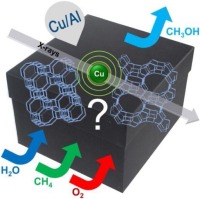Catalysis Today ( IF 5.2 ) Pub Date : 2018-07-20 , DOI: 10.1016/j.cattod.2018.07.028 Elisa Borfecchia , Dimitrios K. Pappas , Michael Dyballa , Kirill A. Lomachenko , Chiara Negri , Matteo Signorile , Gloria Berlier

|
The local structural and electronic properties of Cu sites during the direct conversion of methane to methanol with molecular oxygen was followed by X-ray absorption spectroscopy (XAS) on a set of Cu-zeolites with different topology (large pore MOR and small pore CHA frameworks) and similar chemical composition (Si/Al ∼ 11 and 12, respectively). Two low loading (LL) and high loading (HL) samples were prepared by ion exchange, and their methanol productivity measured in laboratory fixed bed reactor tests, resulting in selectivity higher than 85%. Both Cu-MOR samples outperformed Cu-CHA ones, resulting in 0.28 and 0.26 molCH3OH/molCu for the LL (Cu/Al = 0.13) and HL (Cu/Al = 0.36) samples, vs 0.10 and 0.17 molCH3OH/molCu for LL and HL Cu-CHA, respectively (Cu/Al = 0.16 and 0.49). The evolution of Cu oxidation state and local coordination environment was followed in all the reaction steps (O2 activation, flush with He, CH4 dosage and subsequent CH3OH desorption by applying a wet stream) both during temperature changes (ramp in O2 up to 500 °C, cooling to 200 °C for subsequent steps, etc.) and in steady-state conditions. Strong similarities were observed in the local structure of Cu sites in all samples, which showed similar redox dynamics during O2 activation and subsequent cooling to 200 °C. Even though only qualitative considerations can be made on the overall spectral evolution, XANES indicates that not all the Cu(I) formed during CH4 loading belongs to active sites.
中文翻译:

X-操作XAS监测在Cu-CHA和Cu-MOR沸石上甲烷选择性氧化为甲醇的过程中活性位的演变
在甲烷与分子氧直接转化为甲醇的过程中,铜位的局部结构和电子性质随后通过X射线吸收光谱法(XAS)在一组具有不同拓扑结构(大孔MOR和小孔CHA骨架)的Cu沸石上进行。 )和类似的化学成分(分别为Si / Al〜11和12)。通过离子交换制备了两个低负荷(LL)和高负荷(HL)样品,并在实验室固定床反应器测试中测量了它们的甲醇生产率,结果选择性高于85%。两者的Cu-MOR样品优于铜-CHA的,从而导致0.28和0.26 molCH 3 OH / molCu为LL(铜/铝= 0.13)和HL(铜/铝= 0.36)的样品,VS 0.10和0.17 molCH 3LL和HL Cu-CHA的OH / molCu分别为(Cu / Al = 0.16和0.49)。在温度变化期间(O 2斜坡),在所有反应步骤(O 2活化,用He,CH 4剂量冲洗以及随后通过施加湿流进行CH 3 OH脱附)中跟踪Cu氧化态和局部配位环境的演变。最高温度为500°C,随后的步骤等冷却至200°C,并处于稳态条件下。在所有样品中,Cu位点的局部结构都具有很强的相似性,这表明O 2期间的氧化还原动力学相似。活化并随后冷却至200°C。即使仅对整个光谱演化进行定性考虑,XANES仍表明并非所有在CH 4加载过程中形成的Cu(I)都属于活性位点。











































 京公网安备 11010802027423号
京公网安备 11010802027423号